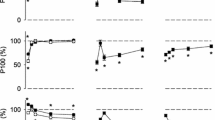Abstract
Rat extensor digitorum longus (EDL) muscles were overloaded by removal of the synergist tibialis anterior (TA). The weight of the overloaded muscle was increased 15 days after the initial operation and remained higher throughout the period studied (153 days). The times to peak twitch tension and half relaxation remained unaltered, but the twitch and tetanic tensions developed by the overloaded EDL muscles increased. The overloaded EDL muscles became significantly more fatigue resistant. In a separate group of animals the overloaded EDL muscle was also chronically stimulated at 10 Hz. The additional stimulation altered the response of the EDL to overload in that the time to peak twitch tension of the muscle was slightly prolonged. There was no increase in twitch or tetanic tension in spite of the increase in muscle weight, but the electrical stimulation led to a further increase in fatigue resistance above that seen in overloaded muscles. The histochemical and immunocytochemical examination of the muscle revealed that there was a moderate increase in succinate dehydrogenase activity in the muscles overloaded only, but a considerable increase in those overloaded muscles that were also stimulated. There was no obvious change in the number of muscle fibres that reacted with an antibody to slow myosin in either overloaded only or overloaded and stimulated EDL muscles. Thus the addition of continuous activity to overload induced a slowing of contraction and prevented the increase of force usually induced by overload.
Similar content being viewed by others
References
Binkhorst RA, Van't Hof MA (1973) Force-velocity relationship and contraction time of the rat fast plantaris muscle due to compensatory hypertrophy. Pflügers Arch 342:145–158
Buller AJ, Pope R (1977) Plasticity in mammalian skeletal muscle. Philos Trans R Soc Lond [Biol] 278:295–305
Degens H, Binkhorst RA, Turek Z (1990) The influence of hypertrophy and training on the contraction characteristics, fatigue and histochemistry of the m. plantaris of the rat. J Neuro Sci [Suppl] 98:388
Dhoot GK, Dransfield I, Grand RJA, Perry SV (1986) Distribution of isoforms of myofibrillar proteins in myoid cells of thymus. J Muscle Res Cell Motil 7:351–360
Frischknecht R, Vrbová G (1991) Response of rat EDL muscles to overload and low-frequency electrical stimulation. J Physiol (Lond) 434:61P
Gutmann E, Schiaffino S, Hanzliková V (1971) Mechanism of compensatory hypertrophy in skeletal muscle of the rat. Exp Neurol 31:451–464
Hudlicka O, Price S, Hoppeler H, Uhlmann E, Egginton S (1988) The effect of long term electrical stimulation on fast muscle with limited blood supply — degeneration and regeneration. In: Gordon T, Stein RB, Smith PA (eds) The current status of peripheral nerve regeneration. Liss, New York, pp 307–316
Ianuzzo CD, Gollnick PHD, Armstrong RB (1976) Compensatory adaptations of skeletal muscle fibre types to a long term functional overload. Life Sci 19:1517–1524
Kennedy JM, Kamel S, Tambone WW, Vrbová G, Zak R (1986) The expression of myosin heavy chain isoforms in normal and hypertrophied chicken slow muscle. J Cell Biol 103:977–983
Kirschbaum JB, Kucher HB, Termin A, Kelly AM, Pette D (1990) Antagonistic effects of chronic low frequency stimulation and thyroid hormone on myosin expression in rat fast-twitch muscle. J Biol Chem 265:13974–13980
Kwong WH, Vrbová G (1981) Effects of low-frequency electrical stimulation on fast and slow muscles of the rat. Pflügers Arch 391:200–207
Nachlas MM, Tsou KC, DeSouza E, Cheng CH, Seligman AM (1957) Cytochemical demonstration of succinic dehydrogenase by the use of a new p-Nitrophenyl substituted ditetrazole. J Histochem Cytochem 5:420–436
Pette D, Vrbová G (1985) Invited review: Neural control of phenotypic expression in mammalian muscle fibres. Muscle Nerve 8:676–689
Reichmann H, Hoppeler H, Mathieu-Costello O, von Bergen F, Pette D (1985) Biochemical and ultrastructural changes of skeletal muscle mitochondria after chronic electrical stimulation in rabbits. Pflügers Arch 404:1–9
Salmons S, Vrbová G (1969) The influence of activity on some contractile characteristics of mammalian fast and slow muscles. J Physiol (Lond) 201:535–549
Schiaffino S, Gorza L, Ausoni S, Bottinelli R, Reggiani C, Larsson L, Edström L, Gundersen K, Lomo T (1990) Muscle fibre types expressing different myosin heavy chain isoforms, their functional properties and adaptive capacity. In: Pette D (ed) The dynamic state of muscle fibres. de Gruyter, Berlin New York, pp 329–341
Termin A, Staron RS, Pette D (1989) Changes in myosin heavy chain isoforms during chronic low-frequency stimulation of rat fast hindlimb muscles. A single-fibre study. Eur J Biochem 186:749–754
Vrbová G (1963) The effect of motoneurone activity on the speed of contraction of striated muscle. J Physiol (Lond) 169:513–526
Author information
Authors and Affiliations
Rights and permissions
About this article
Cite this article
Frischknecht, R., Vrbová, G. Adaptation of rat extensor digitorum longus to overload and increased activity. Pflügers Arch. 419, 319–326 (1991). https://doi.org/10.1007/BF00371113
Received:
Revised:
Accepted:
Issue Date:
DOI: https://doi.org/10.1007/BF00371113




